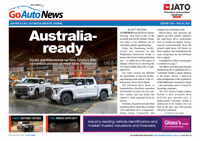Make / Model Search
News - HoldenHolden focusses on LPGGassed: Commodore should match Falcon with dedicated LPG next year. Holden to make its dual-fuel LPG Commodore more affordable as dedicated system nears8 Jul 2008 GM HOLDEN is preparing to cut the price of its LPG dual-fuel option and actively promote the alternative fuel as petrol and diesel prices continue to soar. The company is currently developing a dedicated LPG system for the Alloytec V6 used in the Commodore, a system that is expected to be introduced next year. Until then, Holden will continue to offer its dual-fuel LPG system which is fitted by HSVi at its Elizabeth factory, after the car is produced. Demand for the VE dual-fuel system is still very low despite high petrol prices, with monthly sales of between 80 and 100 units. The high price of the $3900 LPG option is considered one of the main reasons the take up has been slow. Holden is planning to cut the price by at least $1000 and possibly more as it prepares to ramp up LPG production. With a $2000 government subsidy currently available for private customers, the price cut will make the dual-fuel LPG option far more attractive for private customers – including the Rudd government’s so-called families – struggling with petrol prices. The price reduction will be backed by a Holden marketing campaign promoting the benefits of switching to LPG. Holden insiders point out that running an LPG-equipped Commodore is cheaper than a Corolla, although it is not clear if this point will be made in the public marketing program.  Left: GM Holden sales and marketing manager Alan Batey. Left: GM Holden sales and marketing manager Alan Batey.Although it developed a dual-fuel LPG system for the VE Commodore, Holden has not enthusiastically pushed the gas option. Now that the price of petrol is around $1.70 per litre, twice the price of LPG, the company has now decided to heavily back the dual-fuel alternative. “I think that with petrol at $1.70, there are a lot of things that effectively change,” said GM Holden sales and marketing manager Alan Batey. “With petrol at $1.70, LPG is a very relevant discussion.” Mr Batey said that LPG was previously considered a fleet fuel – but that this perception was changing. “I think now people are starting to look at, and think about, LPG,” Mr Batey said. “Interestingly enough, we were out this week talking to our dealers and they are very bullish about LPG, so we are looking at our production. Mr Batey said work was being done to ensure LPG demand would not outstrip supply. “We are looking at our capacities right now and saying that we may need to increase to keep in line with demand,” he said. Holden is planning to fit its upcoming dedicated LPG system in the plant at Elizabeth, but will continue to have HSV install the existing dual-fuel system at its facility at Clayton. “We will keep it as it is because short term that is the best solution,” Mr Batey said. “We are just looking to make sure we have the ability to increase capacity if required.” By doing it this way, the Holden system qualifies for the $2000 government LPG grant because it is deemed an aftermarket system. Ford’s dedicated LPG E-Gas system is installed at its Campbellfield assembly plant as part of the production process and therefore only qualifies for a $1000 grant. Mr Batey admits that convincing private customers to look at LPG new cars, and especially a dedicated LPG model, will be a challenge for Holden’s marketing division. “Going forward we will need to do a really good job of communicating LPG and really getting behind that,” he said. “It is as much a marketing challenge as it is an engineering challenge.” Holden may also decide to offer its existing LPG dual-fuel system on vehicles other than just the entry level Omega model as it attempts to attract non-fleet customers. However, the new VE Commodore Sportwagon has not been designed with LPG in mind and cannot be fitted with the dual-fuel system. This is surprising given that 90 per cent of Commodore VZ station wagon sales went to fleets, which are the most enthusiastic LPG customers. The Holden LPG dual-fuel system is a modern one that uses sequential vapour injection, which is considered more efficient than the single point system in the Ford E-Gas system where LPG is pre-mixed with oxygen before it is sent into the manifold. However, the Holden system does use a lot of LPG, with the fuel economy standing at 16.9L/100km compared to the 14.9L/100km of the Ford E-Gas system. The Holden dual-fuel system also has an LPG tank in the boot, while the Falcon dedicated LGP system means the spare wheel has to be carried in the boot. It is not yet clear whether Holden plans to use liquid fuel injection or a sequential vapour injection with its forthcoming dedicated LPG system. At least one company now offering LPG liquid injection is promising efficiency on par with petrol engines, lower emissions and no power losses. Ford Australia is the market leader in new-car LPG sales in Australia, with around 30 per cent of its cars selected with the E-Gas option. However, the company is still to confirm whether it has approved a plan to introduce an E-Gas version of the new imported Duratec V6 engine which replaces the existing in-line six-cylinder in 2010. While it is understood the new Duratec engine can be adapted to run on LPG, it is unclear whether Ford Australia will have such a system available by the time the Geelong engine plant is closed. Read more:Holden V6 engine push |
Click to shareHolden articlesResearch Holden Motor industry news |









Facebook Twitter Instagram